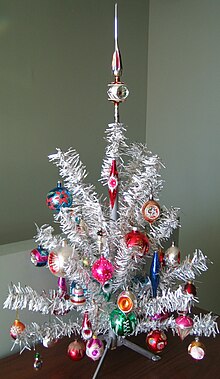
A Christmas tree is a decorated tree, usually an evergreen conifer, such as a spruce, pine or fir, or an artificial tree of similar appearance, associated with the celebration of Christmas.

A ruby is a pinkish red to blood-red colored gemstone, a variety of the mineral corundum. Ruby is one of the most popular traditional jewelry gems and is very durable. Other varieties of gem-quality corundum are called sapphires. Ruby is one of the traditional cardinal gems, alongside amethyst, sapphire, emerald, and diamond. The word ruby comes from ruber, Latin for red. The color of a ruby is due to the element chromium.

Grenadine is a commonly used nonalcoholic bar syrup characterized by its deep red color. It is a popular cocktail ingredient renowned for its flavor as well as its ability to give a reddish or pink tint to mixed drinks. Grenadine is traditionally made from pomegranate.

A Charlie Brown Christmas is a 1965 animated television special. It is the first TV special based on the comic strip Peanuts, by Charles M. Schulz, and features the voices of Peter Robbins, Christopher Shea, Kathy Steinberg, Tracy Stratford, and Bill Melendez. Produced by Lee Mendelson and directed by Melendez, the program made its debut on the CBS television network on December 9, 1965. In the special, Charlie Brown (Robbins) finds himself depressed despite the onset of the cheerful holiday season. After Lucy van Pelt (Stratford) suggests he direct a neighborhood Christmas play, his best efforts are ignored and mocked by his peers when he chooses a puny Christmas tree as a centerpiece.
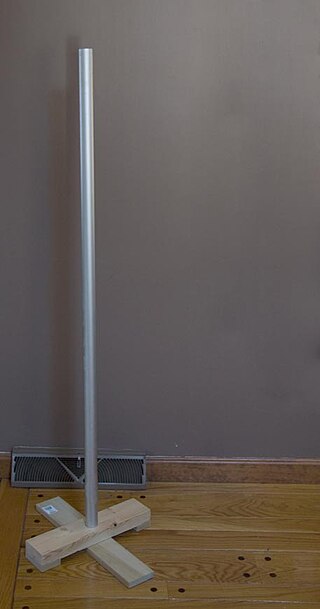
Festivus is a secular holiday celebrated on December 23 as an alternative to the perceived pressures and commercialism of the Christmas season. Originally created by author Daniel O'Keefe, Festivus entered popular culture after it was made the focus of the 1997 Seinfeld episode "The Strike", which O'Keefe's son, Dan O'Keefe, co-wrote.

Tsarskoye Selo was the town containing a former residence of the Russian imperial family and visiting nobility, located 24 kilometers (15 mi) south from the center of Saint Petersburg. The residence now forms part of the town of Pushkin. Tsarskoye Selo forms one of the World Heritage Site Saint Petersburg and Related Groups of Monuments.

Christmas lights are lights often used for decoration in celebration of Christmas, often on display throughout the Christmas season including Advent and Christmastide. The custom goes back to when Christmas trees were decorated with candles, which symbolized Christ being the light of the world. The Christmas trees were brought by Christians into their homes in early modern Germany.

The Rich's Great Tree, now the Macy's Great Tree, was a large 70–90-foot (21–27 m) tall cut pine Christmas tree that had been an Atlanta tradition since 1948. As of 2013, the tree has been replaced by a much smaller artificial one in the parking lot, which was then moved back to the roof for 2014. Before ending the tradition in December 2023.

The blue spruce, also commonly known as green spruce, Colorado spruce, or Colorado blue spruce, is a species of spruce tree. It is native to North America, and is found in USDA growing zones 1 through 7. It is found naturally in Arizona, Colorado, Idaho, New Mexico, Utah and Wyoming. It has been widely introduced elsewhere and is used as an ornamental tree in many places far beyond its native range. It does well in zones warmer than 7 where summer heat is moderate, as at San Francisco. The blue spruce has blue-green colored needles and is a coniferous tree.

A Christmas decoration is any of several types of ornamentation used at Christmastide and the greater holiday season. The traditional colors of Christmas are pine green (evergreen), snow white, and heart red. Gold and silver are also prevalent, as are other metallic colours. Typical images on Christmas decorations include Baby Jesus, Mother Mary, angels, Father Christmas, Santa Claus, and the star of Bethlehem. Advent wreaths, nativity scenes, illuminations, and Moravian stars are popular Christmas decorations.

The White House Christmas Tree, also known as the Blue Room Christmas Tree, is the official indoor Christmas tree at the residence of the president of the United States, the White House. The first indoor Christmas tree was installed in the White House sometime in the 19th century and since 1961 the tree has had a themed motif at the discretion of the First Lady of the United States.

A toilet brush is a tool for cleaning a toilet bowl.

The National Christmas Tree is a large evergreen tree located in the northeast quadrant of the Ellipse near the White House in Washington, D.C. Each year since 1923, the tree has been decorated as a Christmas tree. Every year, early in December, the tree is traditionally lit by the President and First Lady of the United States. Every president since Franklin D. Roosevelt has also made formal remarks during the tree lighting ceremony.
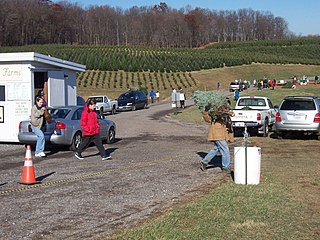
Christmas tree production occurs worldwide on Christmas tree farms, in artificial tree factories and from native strands of pine and fir trees. Christmas trees, pine and fir trees purposely grown for use as a Christmas tree, are grown on plantations in many western nations, including Australia, the United Kingdom and the United States. In Australia, the industry is relatively new, and nations such as the United States, Germany and Canada are among world leaders in annual production.
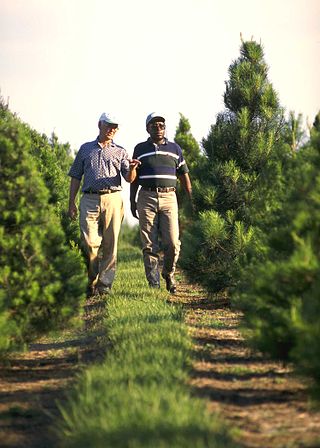
Christmas tree cultivation is an agricultural, forestry, and horticultural occupation which involves growing pine, spruce, and fir trees specifically for use as Christmas trees.

While the first Christmas tree farm may have appeared as early as 1901, Christmas tree production in the United States was largely limited to what could be harvested from natural forests until the 1950s. Among the important Christmas tree producing areas in the U.S. are Wisconsin, North Carolina, Pennsylvania and the Pacific Northwest. In 2002 Christmas tree production in the United States totaled 20.8 million trees and the U.S. was one of the world's leading producers of natural Christmas trees. That same year, Pennsylvania was the top producer in the United States.
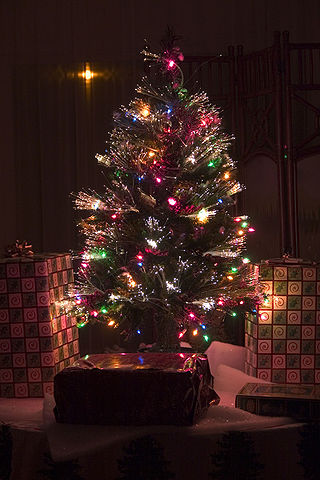
An artificial Christmas tree is an artificial pine or fir tree manufactured for the specific purpose of use as a Christmas tree. The earliest artificial Christmas trees were wooden, tree-shaped pyramids or feather trees, both developed by Germans. Most modern trees are made of polyvinyl chloride (PVC) but many other types of trees have been and are available, including aluminum Christmas trees and fiber-optic illuminated Christmas trees.
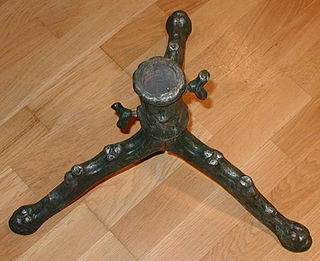
A Christmas tree stand is an object designed to support a cut, natural or an artificial Christmas tree. Christmas tree stands appeared as early as 1876 and have had various designs over the years. Those stands designed for natural trees have a water-well, which, in many cases may not hold enough water to adequately supply the cut tree. Some specialty Christmas tree stands have value on the secondary antiques market.
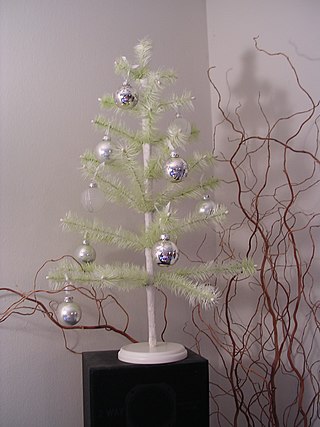
A feather Christmas tree is a type of artificial Christmas tree that is generally considered one of the first artificial trees used as a Christmas tree. They originated in Germany in the late 19th century and became popular in the United States during the early 20th century.

A Singing Christmas Tree, sometimes called a Living Christmas Tree, is an artificial Christmas tree filled with singers used as part of nativity plays.
